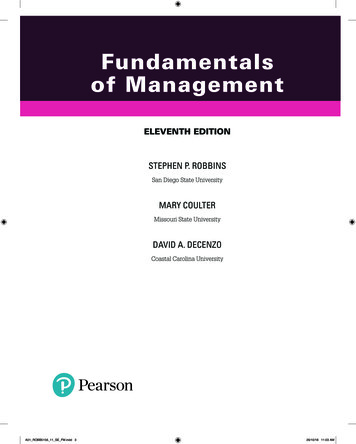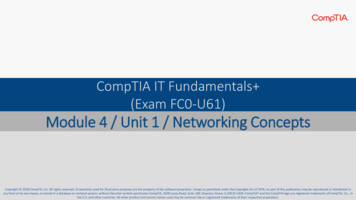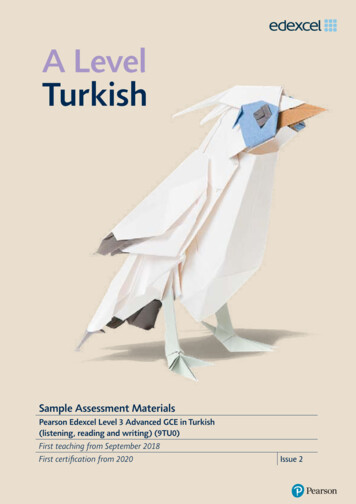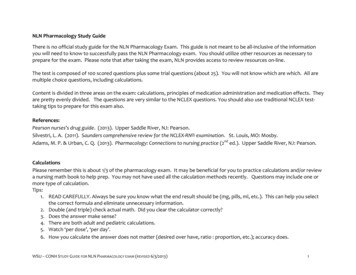
Transcription
Fundamentalsof ManagementELEVENTH EDITIONSTEPHEN P. ROBBINSSan Diego State UniversityMARY COULTERMissouri State UniversityDAVID A. DECENZOCoastal Carolina UniversityA01 ROBB5156 11 SE FM.indd 326/10/18 11:03 AM
Vice President, Business, Economics, and UKCourseware: Donna BattistaDirector of Portfolio Management: Stephanie WallSpecialist Portfolio Manager: Kris Ellis-LevyEditorial Assistant: Amanda McHughVice President, Product Marketing: Roxanne McCarleySenior Product Marketer: Carlie MarvelProduct Marketing Assistant: Marianela SilvestriManager of Field Marketing, Business Publishing:Adam GoldsteinField Marketing Manager: Nicole PriceVice President, Production and Digital Studio, Artsand Business: Etain O’DeaDirector, Production and Digital Studio, Businessand Economics: Ashley SantoraManaging Producer, Business: Melissa FeimerSenior Content Producer: Claudia FernandesOperations Specialist: Carol MelvilleDesign Lead: Kathryn FootManager, Learning Tools: Brian SuretteLearning Tools Strategist: Michael TrinchettoManaging Producer, Digital Studio and GLP: JamesBatemanManaging Producer, Digital Studio: Diane LombardoDigital Studio Producer: Monique LawrenceDigital Studio Producer: Alana ColesFull Service Project Management, Interior Design,Cover Design: Integra Software Services Pvt Ltd.Printer/Binder: LSC-CommunicationsCover Printer: Phoenix ColorMicrosoft and/or its respective suppliers make no representations about the suitability of the information containedin the documents and related graphics published as part of the services for any purpose. All such documents andrelated graphics are provided “as is” without warranty of any kind. Microsoft and/or its respective suppliers herebydisclaim all warranties and conditions with regard to this information, including all warranties and conditions ofmerchantability, whether express, implied or statutory, fitness for a particular purpose, title and non-infringement. In noevent shall Microsoft and/or its respective suppliers be liable for any special, indirect or consequential damages or anydamages whatsoever resulting from loss of use, data or profits, whether in an action of contract, negligence or othertortious action, arising out of or in connection with the use or performance of information available from the services.The documents and related graphics contained herein could include technical inaccuracies or typographical errors.Changes are periodically added to the information herein. Microsoft and/or its respective suppliers may make improvements and/or changes in the product(s) and/or the program(s) described herein at any time. Partial screen shotsmay be viewed in full within the software version specified.Microsoft and Windows are registered trademarks of the Microsoft Corporation in the U.S.A. and otherc ountries. This book is not sponsored or endorsed by or affiliated with the Microsoft Corporation.Copyright 2020, 2017, 2015 by Pearson Education, Inc. or its affiliates. All Rights Reserved. Manufacturedin the United States of America. This publication is protected by copyright, and permission should be obtained fromthe publisher prior to any prohibited reproduction, storage in a retrieval system, or transmission in any form or byany means, electronic, mechanical, photocopying, recording, or otherwise. For information regarding permissions,request forms, and the appropriate contacts within the Pearson Education Global Rights and Permissions department, please visit www.pearsoned.com/permissions/.Acknowledgments of third-party content appear on the appropriate page within the text.PEARSON, ALWAYS LEARNING, and MYLAB are exclusive trademarks owned by Pearson Education, Inc. or itsaffiliates in the U.S. and/or other countries.Unless otherwise indicated herein, any third-party trademarks, logos, or icons that may appear in this work are theproperty of their respective owners, and any references to third-party trademarks, logos, icons, or other trade dressare for demonstrative or descriptive purposes only. Such references are not intended to imply any sponsorship,endorsement, authorization, or promotion of Pearson’s products by the owners of such marks, or any relationshipbetween the owner and Pearson Education, Inc., or its affiliates, authors, licensees, or distributors.Library of Congress Cataloging-in-Publication DataNames: Robbins, Stephen P., author. Coulter, Mary K., author. DeCenzo, David A., author.Title: Fundamentals of management / Stephen P. Robbins, Mary Coulter, DavidA. Decenzo.Description: 11e. New York, NY : Pearson, [2020]Identifiers: LCCN 2018046370 ISBN 9780135175156 ISBN 0135175151Subjects: LCSH: Management.Classification: LCC HD31 .R5643 2020 DDC 658--dc23LC record available at https://lccn.loc.gov/2018046370118ISBN 10: 0-13-517515-1ISBN 13: 978-0-13-517515-6A01 ROBB5156 11 SE FM.indd 426/10/18 11:03 AM
Brief ContentsPart 1 IntroductionChapter 1HistoryModuleChapter 2Chapter 3Managers and Management in Today’s WorkplaceA Brief History of Management’s RootsThe Management Environment 38Important Managerial Issues 64230Part 2 PlanningChapter 4QuantitativeModuleChapter 5Chapter 6Chapter 7Making Decisions90Quantitative Decision-Making Tools 122Planning and Goal Setting 130Managing Change and Innovation 164Managing Entrepreneurial Ventures 194Part 3 OrganizingChapter 8Chapter 9ProfessionalismModuleChapter 10Organizational Structure and Design 228Managing Human Resources and DiversityProfessionalism and Employability 305Managing Work Groups and Work Teams264310Part 4 LeadingChapter 11Chapter 12Chapter 13Chapter 14Understanding Individual Behavior 340Motivating and Rewarding Employees 376Leadership and Trust 408Managing Organizational and Interpersonal Communication 440Part 5 ControllingChapter 15Controlling Work and Organizational ProcessesOperationsModuleManaging OperationsGlossaryIndex470500519526vA01 ROBB5156 11 SE FM.indd 526/10/18 11:03 AM
ContentsContent highlighted in purple indicates that it is presented via a visual spread.PrefacexivApplying: Getting Ready for the WorkplaceInstructor Teaching ResourcesAbout the AuthorsManagement Skill Builder Becoming Politically Adept 23 Experiential Exercise 24 Case Application #1—TrainingBetter Managers . . . Now at Walmart 25 Case Application #2—Who Needs a Boss? 26 CaseApplication #3—Destroying the World 27 Endnotes 28xxiixxivPart 1 IntroductionHistory Module: A Brief History of Management’sRoots 30Chapter 1 M anagers and Managementin Today’s Workplace 2Who Are Managers and Where Do They Work?Early Management5What Three Characteristics Do All Organizations Share?530Classical Approaches 31How Are Managers Different from NonmanagerialEmployees? 6Other Early Twentieth-Century Contributors: A Diversity Perspective 32What Titles Do Managers Have? 6Behavioral ApproachClassic Concepts in Today’s WorkplaceWhat Is Management?Quantitative Approach7Endnotes3 WAYS TO LOOK AT WHAT MANAGERS DOChapter 2 The Management Environment1038What Is the External Environment and WhyIs It Important? 41What Is the Economy Like Today?Making Ethical Decisions in Today’s WorkplaceWhat Role Do Demographics Play?14What Factors Are Reshaping and RedefiningManagement? 15Why Are Customers Important to the Manager’sJob? 16Managing Technology in Today’s Workplace Is It StillManaging When What You’re Managing AreRobots? 16Why Is Innovation Important to the Manager’s Job?17Importance of Social Media to the Manager’s Job17Importance of Sustainability to the Manager’s Job18What Employability Skills Are Critical for Getting andKeeping a Job? 18Wrapping It Up . . . 20Knowing: Getting Ready for Exams and Quizzes2241Classic Concepts in Today’s Workplace14Chapter Summary By Learning Outcome Discussion Questions 2335379Is the Manager’s Job Universal? 11Why Study Management?34Contemporary Approaches84 Functions Approach 9Management Roles ApproachSkills and Competencies 11334344How Does the External Environment AffectManagers? 45Managing Technology in Today’s Workplace Can Technology Improve the Way Managers Manage?Making Ethical Decisions in Today’s Workplace 47WHAT IS ORGANIZATIONAL CULTURE?Dimensions of Organizational Culture4950How Does Organizational Culture Affect Managers?How Does Culture Affect What Employees Do?How Does Culture Affect What Managers Do?Creating a Customer-Responsive CultureCreating a Sustainability Culture515152What Are Current Issues in Organizational Culture?Creating an Innovative Culture4553535354viA01 ROBB5156 11 SE FM.indd 626/10/18 11:03 AM
Cont ent sCreating an Ethical CultureCreating a Learning Culture55What Common Errors Are Committed in the DecisionMaking Process? 9755Knowing: Getting Ready for Exams and QuizzesChapter Summary by Learning Outcome 56 Questions 56DiscussionApplying: Getting Ready for the WorkplaceManagement Skill Builder Understanding C ulture 57 Experiential Exercise 58 Case Application #1—Bad Ride. BumpyRide. 59 Case Application #2—Not Sold Out 60 Case Application #3—Extreme Openness 61 Endnotes 62Chapter 3 Important Managerial Issues64What Is Globalization and How Does It AffectOrganizations? 67What Do Managers Need to Know about Managing in aGlobal Organization? 71Classic Concepts in Today’s Workplace 72What Does Society Expect from Organizationsand Managers? 7475What Is Sustainability and Why Is It Important?76Making Ethical Decisions in Today's Workplace77How Can Managers Encourage Ethical Behavior?78Managing Technology in Today’s Workplace The Ethicsof Data Analytics 79Knowing: Getting Ready for Exams and QuizzesDiscussionManagement Skill Builder Building High Ethical Standards 83 Experiential Exercise 84 Case Application #1—GlobalControl 85 Case Application #2—Serious aboutSustainability? 86 Case Application #3—Flagrant Foul 87 Endnotes 88Planning93What is Relevant in the Decision-Making Process?94How Does the Decision Maker Weight the Criteria andAnalyze Alternatives? 94108How Can You Improve Group Decision Making?108Why Are Creativity and Design Thinking Importantin Decision Making? 110How is big data changing the way managers makedecisions? 112Knowing: Getting Ready for Exams and QuizzesDiscussionApplying: Getting Ready for the WorkplaceManagement Skill Builder Being A Creative Decision Maker 115 Experiential Exercise 116 Case Application #1—BigBrown Numbers 117 Case Application #2—The Business ofBaseball 118 Case Application #3—Slicing the Line 119 Endnotes 120Decision Trees 123Break-Even Analysis 124Linear Programming 125Queuing Theory 1279696What is the Last Step in the Decision Process? 97A01 ROBB5156 11 SE FM.indd 7107Making Ethical Decisions in Today's WorkplacePayoff Matrices 12293What Happens in Decision Implementation?When Are Groups Most Effective?Quantitative Module: Quantitative DecisionMaking Tools 122Chapter 4 Making Decisions 90What Determines the Best Choice?106What Are the Advantages and Disadvantagesof Group Decision Making? 107Chapter Summary by Learning Outcome 114 Questions 115Applying: Getting Ready for the WorkplaceWhat Defines a Decision Problem?What Decision-Making Conditions Do Managers Face? 106How Does National Culture Affect Managers’ DecisionMaking? 109In What Ways Can Ethics Be Viewed? 78How do Managers Make Decisions?How Are Problems, Types of Decisions, and OrganizationalLevel Integrated? 105What Contemporary Decision-Making IssuesDo Managers Face? 109What Factors Determine Ethical and UnethicalBehavior? 77 How Do Nonprogrammed Decisions Differ fromProgrammed Decisions? 104How Do Groups Make Decisions?How Can Organizations Demonstrate Socially ResponsibleActions? 74Should Organizations Be Socially Involved?103How Does a Manager Make ProgrammedDecisions? 103WHAT ARE THE DIFFERENT TYPES OF GLOBAL ORGANIZATIONS? 70Part 2Rational Model 99Bounded Rationality 100Classic Concepts in Today’s Workplace 101Intuition and Managerial Decision Making 101Managing Technology in Today’s Workplace Making BetterDecisions With Technology 102How Do Problems Differ?68Chapter Summary by Learning Outcome 82Questions 82WHAT ARE THE 3 APPROACHES MANAGERS CANUSE TO MAKE DECISIONS? 99What Types of Decisions and Decision-Making ConditionsDo Managers Face? 103What Does It Mean to Be “Global”? 68How Do Organizations Go Global?viiEconomic Order Quantity ModelEndnotes12712926/10/18 11:03 AM
viiiC ont en tsChapter 5Planning and Goal Setting130How Do Managers Manage Resistanceto Change? 172What Is Planning and Why Do Managers Need toPlan? 133Why Should Managers Formally Plan?Why Do People Resist Organizational Change?133What Are Some Criticisms of Formal Planning and HowShould Managers Respond? 134Does Formal Planning Improve Organizational Performance? 135136Why Is Strategic Management Important?136What Are the Steps in the Strategic Management Process? 137WHAT STRATEGIES DO MANAGERS USE?WHAT REACTION DO EMPLOYEES HAVETO ORGANIZATIONAL CHANGE? 174What Is Stress? 174What Causes Stress? 175What Do Managers Need to Know about Strategic Management? 135What Is Strategic Management?139Corporate Strategy 139Competitive Strategy 140Functional Strategy 140How Can Managers Encourage Innovationin an Organization? 178How Are Creativity and Innovation Related?What’s Involved in Innovation?Making Ethical Decisions in Today’s Workplace143How Do Managers Set Goals and Develop Plans? Helping180Classic Concepts in Today’s WorkplaceMaking Ethical Decisions in Today’s Workplace144146What Types of Plans Do Managers Use and How Do TheyDevelop Those Plans? 147What Contemporary Planning Issues Do ManagersFace? 150How Can Managers Plan Effectively in Dynamic Environments and in Crisis Situations? 151How Can Managers Use Environmental Scanning?152Managing Technology in Today’s Workplace Using Social Media for Environmental Scanning 152Knowing: Getting Ready for Exams and QuizzesChapter Summary by Learning Outcome 154Questions 154 DiscussionApplying: Getting Ready for the WorkplaceManagement Skill Builder Being A Good Goal Setter 155 Experiential Exercise 156 Case Application #1—Fast Fashion 157 Case Application #2—Mapping a New Direction 158 Case Application #3—Using Tech to Sell Pizza 159 Endnotes 161What Is Disruptive Innovation?183183Why Is Disruptive Innovation Important?184What Are the Implications of Disruptive Innovation?184Knowing: Getting Ready for Exams and QuizzesChapter Summary by Learning Outcome 186Questions 186 Applying: Getting Ready for the Workplace187DiscussionExperiential Exercise 188 Case Application #1— Defeating the System 189 Case Application #2—TheNext Big Thing 190 Case Application #3—Time toChange? 191 Endnotes 192Chapter 7Managing Entrepreneurial Ventures 194What Is the Context of Entrepreneurship andWhy Is It Important 197What Is Entrepreneurship?197Is Entrepreneurship Different from Self-Employment?Classic Concepts in Today’s WorkplaceWhy Is Entrepreneurship Important?198199Who’s Starting Entrepreneurial Ventures?What Do Entrepreneurs Do?Chapter 6 Managing Change andInnovation 164182What Is Disruptive Innovation and Why Is Managing itSo Important? 183What Types of Goals Do Organizations Have and How DoThey Set Those Goals? 144199200201WHAT HAPPENS IN THE ENTREPRENEURIAL PROCESS? 202What Is Change and How Do ManagersDeal with It? 167Why Do Organizations Need to Change?168169How Does Organizational Change Happen?A01 ROBB5156 11 SE FM.indd 8179How Does Design Thinking Influence Innovation?141Classic Concepts in Today’s Workplace179Managing Technology in Today’s Workplace Innovation Flourish 180How Can a Manager Foster Innovation?What Strategic Weapons Do Managers Have?Who Initiates Organizational Change?173What Are Some Techniques for Reducing Resistance toOrganizational Change? 173170169Exploring the Entrepreneurial Context 202Identifying Opportunities and Possible CompetitiveAdvantages 202Starting the Venture 203Managing the Venture HOW? 20326/10/18 11:03 AM
ixCont ent sWhat Social Responsibility and Ethics Issues Face Entrepreneurs? 204What’s Involved in Planning New Ventures?205What Initial Efforts Must Entrepreneurs Make? 205How Should Entrepreneurs Research the Venture’s Feasibility? 206What Planning Do Entrepreneurs Need to Do? 209What Additional Planning Considerations Do EntrepreneursNeed to Address? 210What’s Involved in Organizing an Entrepreneurial Venture? 212What Are the Legal Forms of Organizationfor Entrepreneurial Ventures? 212What Type of Organizational Structure Should Entrepreneurial Ventures Use? 212What Human Resource Management Issues Do Entrepreneurs Face? 214What Type of Personality Characteristics Do EntrepreneursHave? 215How Can Entrepreneurs MotivateEmployees? 216How Can Entrepreneurs Be Leaders? 217217What’s Involved in Controlling an EntrepreneurialVenture? 218How Is Growth Managed? 218How Are Downturns Managed? 218What’s Involved with Exiting the Venture? 219Why Is It Important to Think about Managing PersonalChallenges as an Entrepreneur? 219Knowing: Getting Ready for Exams and QuizzesChapter Summary by Learning Outcome 221 DiscussionQuestions 222Applying: Getting Ready for the WorkplaceManagement Skill Builder Developing Grit 222 ExperientialExercise 223 Case Application #1—A Restaurant That DoesMore Than Just Feed Customers 224 Case Application #2 —The X Factor 225 Case Application #3—Eyeing the Future 226 Endnotes 227Part 3 OrganizingMechanistic or Organic 241Strategy Structure 241Size Structure 242Technology Structure 242Environment Structure 2422431 What Is Work Specialization?2312 What Is Departmentalization?What Contemporary Organizational Designs Can ManagersUse? 245What Are Today’s Organizational Design Challenges? 249How Do You Keep Employees Connected?3 What Are Authority and Responsibility?238249How Do Global Differences Affect OrganizationalStructure? 249Making Ethical Decisions in Today's WorkplaceHow Do You Build a Learning Organization?249250How Can Managers Design Efficient and Effective FlexibleWork Arrangements? 251Managing Technology in Today’s Workplace Changing World of Work 253 TheKnowing: Getting Ready for Exams and QuizzesChapter Summary by Learning Outcome 255Questions 255 DiscussionApplying: Getting Ready for the WorkplaceManagement Skill Builder Increasing Your Power 256 Experiential Exercise 257 Case Application #1— Turbulence at United Air 258 Case Application #2—Lift Off 259 Case Application #3—A New Kind ofStructure 260 Endnotes 261 Chapter 9 Managing Human Resourcesand Diversity 264What Is the Human Resource Management Processand What Influences It? 267268270How Do Managers Identify and Select Competent Employees? 271Making Ethical Decisions in Today's Workplace 2711 What Is Employment Planning?232244What Traditional Organizational Designs Can ManagersUse? 244Classic Concepts in Today’s WorkplaceWhat Are the Six Key Elements in Organizational Design? 231A01 ROBB5156 11 SE FM.indd 9WHAT CONTINGENCY VARIABLES AFFECTSTRUCTURAL CHOICE? 240What Is the Legal Environment of HRM? Organizational Structureand Design 2284 What Is Span of Control?239What Are Some Common Organizational Designs?What’s Involved in Leading an EntrepreneurialVenture? 215Chapter 86 What Is Formalization?Classic Concepts in Today’s WorkplaceManaging Technology in Today’s Workplace StartupIdeas: Cashing in on Technology 214Making Ethical Decisions in Today's Workplace5 How Do Centralization and DecentralizationDiffer? 2392712A How Do Organizations Recruit Employees? 2732342B How Does a Manager Handle Layoffs? 2743 How Do Managers Select Job Applicants? 27426/10/18 11:03 AM
xC ont ent sHow Are Employees Provided with Needed Skills andKnowledge? 278How Are New Hires Introduced to the Organization?Managing Technology in Today’s Workplaceand Digital HR 279What Is Employee Training?278 SocialPerformance Management System 282Compensating Employees: Pay and Benefits284287287288How Are Organizations and Managers Adaptingto a Changing Workforce? 289What Types of Diversity Are Found in Workplaces?292How Does Workforce Diversity and Inclusion AffectHRM? 294What about Inclusion? 295Knowing: Getting Ready for Exams and Quizzes Discussion305306307307Take Responsibility for Managing Your Own Career 308Network308308What Makes a Team Effective?323Managing Technology in Today’s WorkplaceConnected: IT And Teams 323 Keeping327What Current Issues Do Managers Facein Managing Teams? 328When Are Teams Not the Answer?330Knowing: Getting Ready for Exams and QuizzesChapter Summary by Learning Outcome 331Questions 331 DiscussionApplying: Getting Ready for the WorkplaceManagement Skill Builder Developing Your CoachingSkills 332 Experiential Exercise 333 CaseApplication #1—Rx: Teamwork 334 Case Application #2—Building Better Software Build Teams 335 CaseApplication #3— Employees Managing Themselves—Good Idea orNot? 336 Endnotes 337Part 4 LeadingChapter 11 Understanding IndividualBehavior 340What Is the Focus of OB?308Seek a Mentor322What Are the Focus and Goals of OrganizationalBehavior? 343308308Stay VisibleWhat Are the Different Types of Work Teams?307Assess Your Personal Strengths and WeaknessesStay Up to Date321What’s Involved with Managing Global Teams? 328Professionalism Module: Professionalism andEmployability 305Practice Makes Perfect316321Are Work Groups and Work Teams the Same?How Can a Manager Shape Team Behavior?Management Skill Builder Providing Good Feedback 297 Experiential Exercise 298 Case Application #1—RaceRelations 299 Case Application #2—Résumé Regrets 300 Case Application #3—SpottingTalent 301 Endnotes 302 Develop Your Interpersonal Skills315320How Are Groups Turned into Effective Teams?What Is Workforce Diversity? 291Chapter Summary by Learning Outcome 296Questions 297Applying: Getting Ready for the Workplace3131 Roles 3162a Norms 3162b Conformity 3173 Status Systems 3174 Group Size 3185 Group Cohesiveness 318Classic Concepts in Today’s WorkplaceHow Can Workforce Diversity and InclusionBe Managed? 291Identify Market Opportunities3135 MAJOR CONCEPTS OF GROUP BEHAVIORHow Can Managers Manage Downsizing?How Can I Have a Successful Career?What Is a Group and What Stages of Development DoGroups Go Through? 313Making Ethical Decisions in Today’s WorkplaceWhat Contemporary HRM Issues Face Managers?How Can I Show My Professionalism?310What Are the Stages of Group Development?KEEPING GREAT PEOPLE: TWO WAYS ORGANIZATIONS DO THIS 282What is Professionalism?TeamsWhat Is a Group?279What Is Sexual Harassment?Chapter 10 Managing Work Groups and Work343What Are the Goals of Organizational Behavior? 344308What Role Do Attitudes Play in Job Performance?345Leverage Your Competitive Advantage 309What Are the Three Components of an Attitude? 345Don’t Shun RisksWhat Attitudes Might Employees Hold?309It’s OK to Change Jobs309Opportunities, Preparation, and Luck SuccessEndnotes309A01 ROBB5156 11 SE FM.indd 10309345Do Individuals’ Attitudes and Behaviors Need to Be Consistent? 346What Is Cognitive Dissonance Theory?34626/10/18 11:03 AM
xiCont ent sMaking Ethical Decisions in Today’s Workplace347How Can an Understanding of Attitudes Help Managers BeMore Effective? 348What Do Managers Need to Know About Personality? 348How Can We Best Describe Personality? 349Managing Technology in Today’s Workplace IncreasedReliance on Emotional Intelligence 351Can Personality Traits Predict Practical Work-RelatedBehaviors? 351How Do We Match Personalities and Jobs?353Do Personality Attributes Differ Across Cultures?354How Can an Understanding of Personality Help ManagersBe More Effective? 354What Is Perception and What Influences It?What Influences Perception?How Does Job Design Influence Motivation?Classic Concepts in Today’s WorkplaceWhat Is Equity Theory?385386388How Does Expectancy Theory Explain Motivation? 389How Can We Integrate Contemporary MotivationTheories? 390What Current Motivation Issues Do ManagersFace? 392How Can Managers Motivate Employees When theEconomy Stinks? 392How Does Country Culture Affect Motivation Efforts?How Can Managers Motivate Unique Groups ofWorkers? 393Making Ethical Decisions on Today’s Workplace355392394How Can Managers Design Appropriate RewardsPrograms? 395355How Do Managers Judge Employees? 356How Can an Understanding of Perception Help ManagersBe More Effective? 358Managing Technology in Today’s Workplace IndividualizedRewards 396Knowing: Getting Ready for Exams and QuizzesHOW DO LEARNING THEORIES EXPLAIN BEHAVIOR? 359Chapter Summary by Learning Outcome 398Questions 399Operant conditioning 359Social learning theory 360Shaping Behavior 360Applying: Getting Ready for the WorkplaceClassic Concepts in Today’s Workplace362What Contemporary OB Issues Face Managers?362How Do Generational Differences Affectthe Workplace? 362Knowing: Getting Ready for Exams and QuizzesChapter Summary by Learning Outcome 366Questions 367 DiscussionDiscussionManagement Skill Builder Being a Good Motivator 399 Experiential Exercise 400 Case Application #1—Onefor the Money . . . 401 Case Application #2—UnlimitedVacation Time? Really? 402 Case Application #3—Passionate Pursuits 403 Endnotes 404Chapter 13 Leadership and TrustHow Do Managers Deal with Negative Behavior in theWorkplace? 364 408Who Are Leaders, and What Is Leadership? 411Classic Concepts in Today’s Workplace 411WHAT DO EARLY LEADERSHIP THEORIES TELLUS ABOUT LEADERSHIP? 412Management Skill Builder Understanding EmployeeEmotions 367 Experiential Exercise 369 Case Application #1—Getting All Emotional at Google 369 CaseApplication #2 —Putting Customers Second 370 Case Application #3—Adobe’s Advantage 371 Endnotes 372THE LEADER What Traits Do Leaders Have? 412THE BEHAVIORS What Behaviors Do Leaders Exhibit? 414University of Iowa 414Ohio State 414University of Michigan 414Managerial Grid 414Chapter 12 Motivating and RewardingEmployees 376What Do the Contingency Theories of LeadershipTell Us? 415Applying: Getting Ready for the WorkplaceWhat Is Motivation?What Was the First Comprehensive Contingency Model? 4153794 EARLY THEORIES OF MOTIVATION (1950s &1960s) 3801 Maslow’s Hierarchy of Needs Theory 3802 McGregor’s Theory X and Theory Y 3813 Herzberg’s Two-Factor Theory 3814 McClelland’s Three-Needs Theory 383How Do the Contemporary Theories Explain Motivation? 384What Is Goal-Setting Theory?A01 ROBB5156 11 SE FM.indd 11384How Do Followers’ Willingness and Ability InfluenceLeaders? 416How Participative Should a Leader Be?How Do Leaders Help Followers?What Is Leadership Like Today?418419420What Do the Four Contemporary Views of LeadershipTell Us? 421Making Ethical Decisions in Today’s WorkplaceWhat Issues Do Today’s Leaders Face?423424Managing Technology in Today’s WorkplaceLeadership 425 Virtual26/10/18 11:03 AM
xiiC ont en tsWhy Is Trust the Essence of Leadership?A Final Thought Regarding Leadership427Applying: Getting Ready for the Workplace429Knowing: Getting Ready for Exams and QuizzesChapter Summary by Learning Outcome 430Questions 431 DiscussionApplying: Getting Ready for the WorkplaceManagement Skill Builder Being A Good Leader 431 Experiential Exercise 432 Case Application #1—“Success Theater” at General Electric 433 Case Application#2—Developing Gen Y Leaders 434 Case Application#3—Investing in Leadership 435 Endnotes 436440How Do Managers Communicate Effectively?443How Does the Communication Process Work?443Is the Grapevine an Effective Way to Communicate?445445446What Is Control and Why Is It Important?473What Takes Place as Managers Control?475475Making Ethical Decisions in Today’s WorkplaceClassic Concepts in Today’s Workplace 4783 What Managerial Action Can Be Taken?479480480KEEPING TRACK: WHAT GETS CONTROLLED? 482Keeping Track of an Organization’s Finances 482Keeping Track of Organization’s Information 483Keeping Track of Employee Performance 484Keeping Track Using a Balanced Scorecard ApproachTECHNOLOGY AND MANAGERIALCOMMUNICATION 451Networked Communication 451Mobile Communication 452 Office ofWhat Communication Issues Do Managers FaceToday? 455How Do We Manage Communication in an InternetWorld? 455Do Controls Need to Be Adjusted for CulturalDifferences? 486Managing Technology in Today’s Workplace MonitoringEmployees 487What Challenges Do Managers Face in Controlling theWorkplace? 487Knowing: Getting Ready for Exams and QuizzesWhat Role Does Communication Play in CustomerService? 458Chapter Summary by Learning Outcome 492Questions 492How Can We Get Employee Input and Why ShouldWe? 458Applying: Getting Ready for the Workplace459How Do We Have Civil Conversations in theWorkplace? 459How Does Workplace Design AffectCommunication? 460Why Should Managers Be Concerned withCommunicating Ethically? 461A01 ROBB5156 11 SE FM.indd 12 DiscussionManagement Skill Builder Disciplining Difficult Employees 493 Experiential Exercise 494 Case Application #1—HealthyFast Food? 495 Case Application #2—If You Can’tSay Something Nice, Don’t Say Anything at All 496 Case Application #3—Goals and Controls 496 Endnotes 498Operations Module: Managing OperationsKnowing: Getting Ready for Exams and QuizzesChapter Summary by Learning Outcome 462Questions 462485What Contemporary Control Issues Do Managers Confront? 486How Does Knowledge Management AffectCommunication? 457Making Ethical Decisions in Today’s Workplace4762 How Do Managers Compare Actual Performanceto Planned Goals? 478When Does Control Take Place?How Can Managers Overcome Communication Barriers? 449473473Why Is Control Important?What Should Managers Control?What Barriers Keep Communication from Being Effective? 446Managing Technology in Today’s WorkplaceTomorrow 454Chapter 15 Controlling Work and OrganizationalProcesses 4701 What Is Measuring?Are Written Communications More Effective Than VerbalOnes? 445Classic Concepts in Today’s WorkplacePart 5 ControllingWhat Is Control?Chapter 14 Managing Organizational andInterpersonal CommunicationHow Do Nonverbal Cues Affect Communication?Management Skill Builder Being A Good Listener 463 Experienti
v Brief Contents Part 1 Introduction Chapter 1 Managers and Management in Today’s Workplace 2 History Module A Brief History of Management’s Roots 30 Chapter 2 The Management Environment 38 Chapter 3 Important Managerial Issues 64 Part 2 Planning Chapter 4 Making Decisions 90 Quantitative Module Quantitative Decisi










